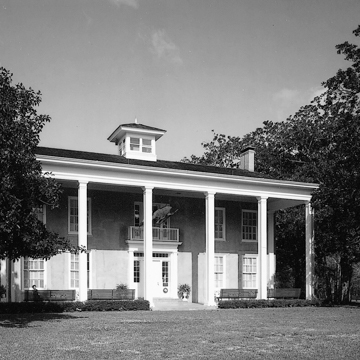The road Josiah H. Bell surveyed to connect what became East and West Columbia is today called Brazos Avenue. North of Brazos Avenue is the Martin Varner League, a 4,428-acre tract on the west bank of the Brazos River that is bisected by what came to be called Varner Creek. In 1957, Houston collector and philanthropist Ima Hogg, whose father bought this property in 1901, gave sixty-five acres to the State of Texas to become the Varner-Hogg Plantation State Historic Site. The park is centered on what had been the plantation headquarters and contains the original C. R. Patton house and archaeological remains of the sugar house, as well as service buildings constructed by the Hogg family in 1920.
The two-story brick I-house has a central hall flanked by equally sized rooms on both floors. Double-level galleries originally faced the west (approach) and east (creek) fronts of the house. Rising from the center of the low-pitched, side-gabled roof was a cupola. North of the house is a freestanding one- and two-story brick building containing the dining room, kitchen, and smoke house. The house was built about 1836 by Patton, who came to Mexican Texas from Kentucky in 1834 with his parents, brothers, sisters, and slaves. The Pattons and their slaves, numbering 83 by 1860, grew and processed sugar cane on the league C. R. Patton purchased from Martin Varner, to whom the property had been granted in 1824.
After the Civil War, the plantation was never profitable. It was sold by Patton's niece in 1869 and, until bought by J. S. Hogg, was owned by a sequence of interconnected investor syndicates. From 1874 until 1882, managers contracted with the state prison system to lease convicts as agricultural laborers. Since the convicts were largely African American, this practice, which was controversial and plagued by abuse and exploitation, seemed like a barely disguised reinstitution of slavery. Sharecropping was instituted after 1882. After the onset of the Panic of 1893, sugar cane cultivation ceased. The Storm of 1900 destroyed most of the agricultural outbuildings, including the sugar house on the east side of Varner Creek. Austin lawyer J. S. Hogg, governor of Texas from 1891 to 1895, instructed his four children not to sell the property for a term of years after his death in 1906 because of his conviction that it possessed oil reserves. In January 1918, the Tyndall-Hogg No. 2 well was brought in, opening the West Columbia oilfield and providing Hogg's children, especially Will C. Hogg and Ima Hogg, with the resources that fueled their careers as Houston civic and cultural leaders. Photographs on display at the site today show the parklike meadow west of the house thick with the wooden derricks of producing oil wells.
In 1919–1920, Will Hogg had Houston architect Birdsall P. Briscoe, a descendant of several of the Austin colony's 300 families, remodel the main house and design a series of outbuildings. Briscoe demolished the west-facing gallery and replaced it with a double-height portico supported by paneled columns. Wider than the veranda, the portico occasioned the reconfiguration of the roof, as can be seen from the side of the house; Briscoe raised new pitched planes above the existing roof, reproducing the square-plan cupola on top but glazing it. Briscoe linked the kitchen/dining room/smoke house to the north side of the house with a breezeway and proposed a new wing south of the main house repeating this configuration and evoking associations with George Washington's Mount Vernon. The south wing was never built. Once the oil derricks were cleared out, the grand west side became the new front of the Hogg House, replacing the east, creek, elevation. Briscoe also replaced the veranda on the creek front of the house with a new double veranda that discreetly encloses an end bay to contain indoor bathrooms. The east entrance preserves the original arrangement of solidly paneled double doors. The present interiors were installed by Houston decorator Dorothy Dawes Chillman. However, the plainness of the interior of the house and its north out-building remains quite evident.
The Hogg and Briscoe alterations were meant to make Will Hogg's romantic vision of the Varner as a Southern plantation more explicit and tangible. The house is a remarkable odyssey in twentieth-century cultural interpretation. Just as remarkable are Briscoe's out-buildings, which include several houses along the entrance drive. These are regional revivals of the Gulf Coast cottages that Briscoe, who was born in 1876, would have known from his childhood. Regionalism did not enter the consciousness of Texas architects until the end of the 1920s, and even then they tended not to focus on such ordinary types as wood cottages. Briscoe's single and double houses seem all the more remarkable because they are so straightforward, as though the builders responsible for the houses along Main Street in East Columbia had simply skipped over the last quarter of the nineteenth century and kept going.

